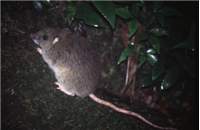Family
MuridaeGenus
Rattus
Species
fuscipes
Threats/Control Methods - Regional
Human disturbance through land clearing for forestry, agriculture and urban development have a direct impact on lowering the number of this forest dependant species. Bush fires are also a major threat, as they remove the necessary ground cover, however the species has adapted to this relatively natural occurrence through their diet, burrowing habits and far-ranging territories.
Threats/Control Methods - Local
The availability of native forest and woodland areas with good ground cover are decreasing with greater urban developments and roads. Domestic pets, especially free roaming Cats (Felis catus ) will hunt this species.
Local/Urban Actions
Domestic cats provided with a stimulating indoor environment and cat enclosure are likely to live 4 times longer than free roaming cats and will reduce the number of native species hunted within the suburbs and surrounding nature reserves. Joining in the revegetation activities organised by Greening Australia and Landcare can help maintain the habitat in Canberra's surrounding forest and woodland areas.
Common name/s
Allied Rat, Southern Bush Rat
Distinguishing Features
This rodent is covered with soft, dense fur. It is grey-brown and red-brown with light grey-brown underparts. Its size varies significantly in different areas and between the sexes, as females are much smaller. The length of their head and body ranges from 12-21cm and their tail length from 11-19cm. The tail can be brown, grey or black and is always slightly shorter than the body. It has round pink-brown ears, long whiskers and dark, round eyes. The feet can be white, pink, grey or brown and the hindfeet are often darker that the forefeet.
Similar Species
The introduced Black Rat (Rattus rattus ) has a much longer tail relative to its body.
Distribution
This species is widely distributed within the coastal forests of NSW, QLD and VIC. It is also found in the southwest corner of WA and throughout the inland forests within VIC and southern NSW.
Country of Origin
Australia
Survey Techniques
Trapping
Conservation (Pet/Pest) Status - National
Secure, not listed under the EPBC Act 1999.
Conservation (Pet/Pest) Status - Regional
Common to undisturbed native bushland areas, while decreasing in developing areas.
Associated vegetation community
Forest and coastal areas are the preferred habitat of this species, including subalpine woodland, coastal scrub, eucalypt forest and rainforest.
Limiting Resources
The Bush Rat is entirely dependant on the preservation of its natural habitat, as its population density mirrors the density of forest understory, as it depends on this ground cover for shelter and food. A low amount of rainfall to an area will also limit numbers, as does bushfire and human disturbance.
Breeding
The well-known southeastern subspecies of Bush Rat can breed throughout the year, but tends not to during the winter months. A litter usually consists of five new young. A female may produce several litters in a good season. After four or five weeks of feeding from their mother, the young become completely dependent. At four months of age young rats are ready to reproduce themselves.
Behaviour
The Bush Rat uses odour, touch, sounds and visual identification to communicate amongst one another. However, this species is not social, spending its life largely alone. Young rats move away from their birthplace to find their own small territory for surviving the winter. In the lead up to wintertime they increase their body hair and put on more fat. Over spring and summer, they begin to travel great distances, with males covering a kilometre in a night. During a bushfire event, they take shelter in their burrows. They are common to nature reserves, however they are rarely seen due to their shy nature and nocturnal behaviour.
Functional Group
Food Species
The Bush Rat is the most insectivorous of all Australia's native rats, usually eating insects found on the forest floor. However, if this food supply becomes scarce after a bushfire event, they will survive by eating the fungi that rapidly emerges. During spring and summer, fruits and seeds also contribute to the diet, while in winter the stems and leaves of certain grasses and lilies are also eaten.
Predators
Foxes (Vulpes vulpes ) and feral and domestic Cats (Felis catus ) commonly prey upon the native Bush Rat.
Interesting Fact
In autumn, almost all the adult males and females die, leaving the young of the previous summer to carry on the population.
References - (reader suitability of references, P=Primary teachers, S=Secondary students, T=Tertiary students and researchers)
Books:
Strahan, R. (ed.) 1995. The Mammals of Australia. Australian Museum Trust/Reed Books. Chatswood NSW. P, S, T
Online Publications:
Department of Primary Industries. 2004. Cats and Wildlife - how you can protect both. The State of Victoria. [online]. Available at: http://www.dpi.vic.gov.au/dpi/nreninf.nsf/childdocs/-9599F8E44B161F63CA256BC800079622-ADE2FBD0C557DFF5CA256BC8000909B9-0BBDC63C90B4E1EE4A256DEA00293306-705022D77BF3233FCA256BCF00088822?open P, S, T
Tidemann, C., Roscoe, T. and Mitchell B. 2006. Mammals of the Lower Sullivans Creek Catchment, Canberra ACT. Prepared for the Life in the Suburbs project using data from the Lower Sullivans Creek Catchment Ecological Survey (LSCCES). Australian National University. Canberra. [online]. Available at: http://www.lifeinthesuburbs.com.au/category.php?id=65 S, T
NSW Parks and Wildlife Service. 2001. Threat Abatement Plan for Predation by the Red Fox (Vulpes vulpes). NSW Parks and Wildlife Service. Hurstville. S, T
Researcher: Naomi Hogan

 Top
Top Top
Top